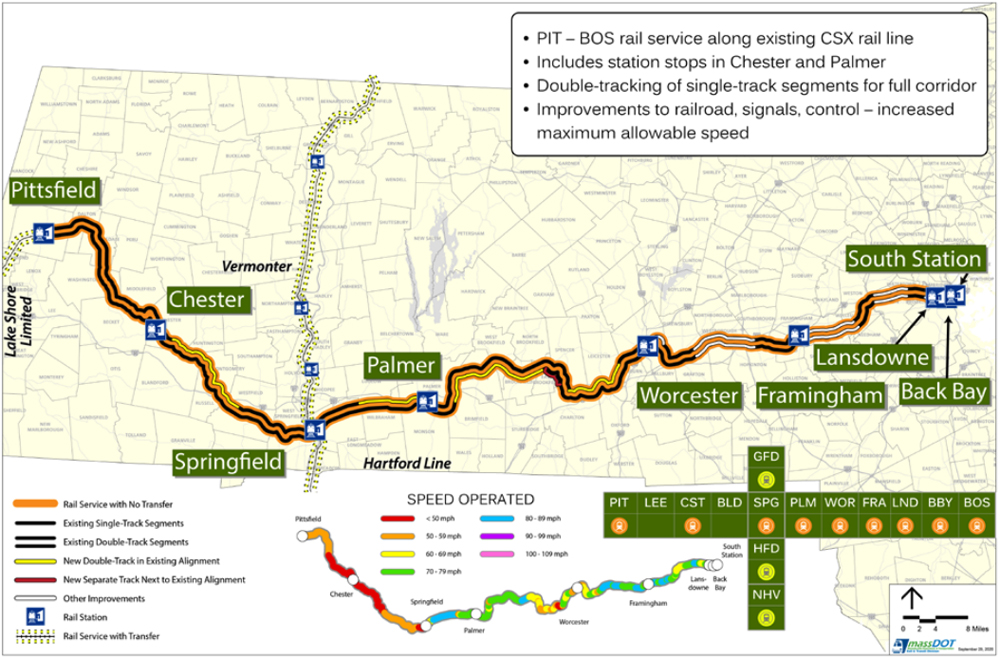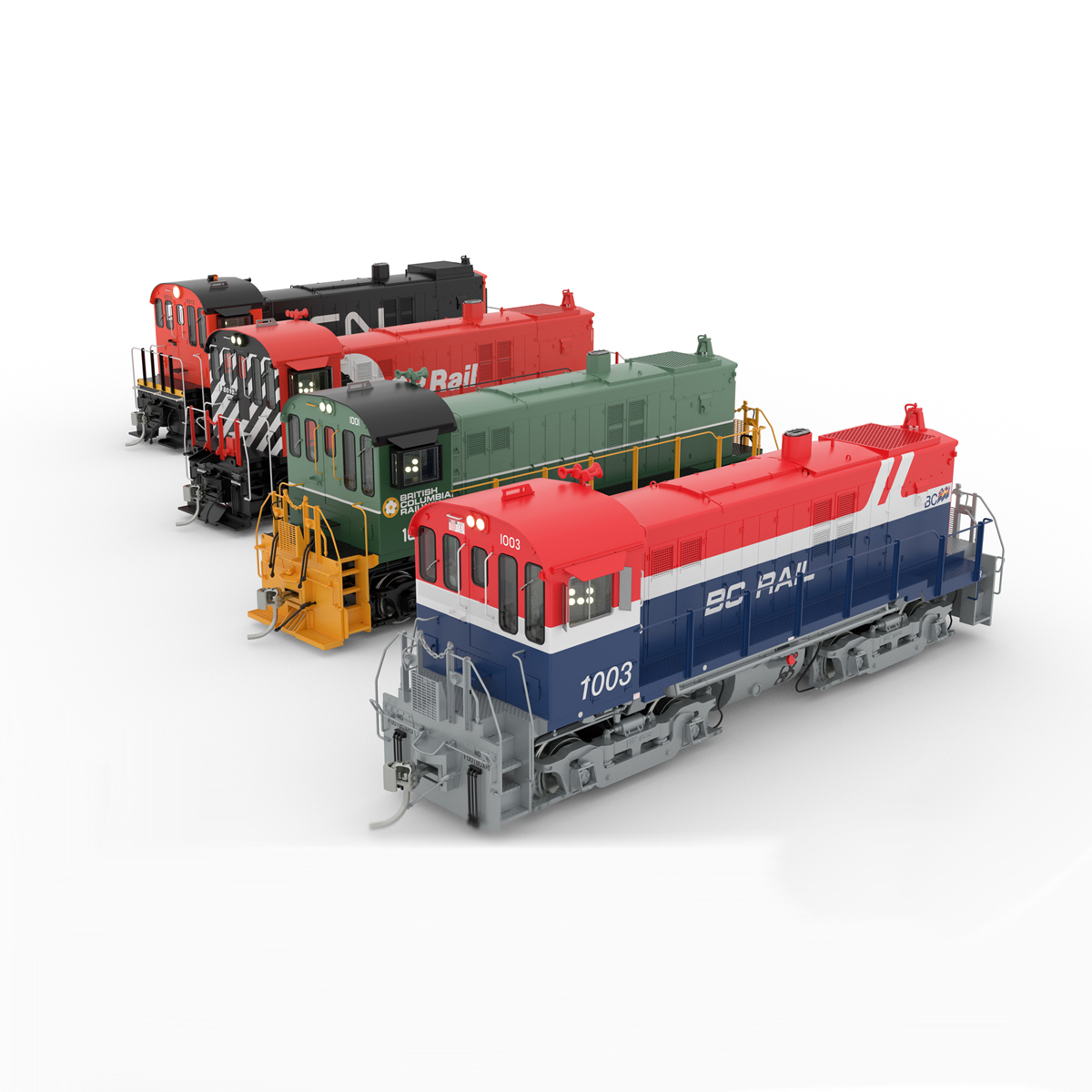
SPRINGFIELD, Mass. — The Massachusetts Department of Transportation, Amtrak, and CSX Transportation are seeking $108 million in federal grants to improve the rail line between Springfield and Worcester, Mass., as part of the proposed East-West Rail project.
The three entities announced the grant application Friday, MassLive.com reports, with the goal of adding two daily Amtrak round trips between Boston and Springfield once the 53-mile Springfield-Worcester segment is upgraded. MassDOT will contribute an additional $18 million and Amtrak will add $9 million toward the project.
The application was for the Consolidated Rail Infrastructure and Safety Improvements, or CRISI, grant program for fiscal 2022, which had a Dec. 1 application deadline.
Improvements would increase the top speed on the Springfield-Worcester segment to 80 mph, also reducing travel times for the Boston section of the Lake Shore Limited, MassDOT said in a press release.
CSX had agreed to support the project as part of it effort to win approval for acquisition of Pan Am Railways, which was granted in April.














My past work often had me lay over in Hartford. With relatives in Boston very inconvient to get to Boston. What I would have done for inland route service. In far future inland route servie Hartford – Providence may happen.
Hartford Providence is long since obliterated. Maybe around 1959 or so my father was detoured over that line returning from New York to Massachusetts.
The Inland Route Boston – Springfield – Hartford – New Haven was run in the early Amtrak years, but I think only once daily which of course didn’t make it a corridor. It’s a natural. Alan, look at automobile travel. Lots of Boston – New York auto traffic goes via I-90 near Worcester, not via Providence.
There are plenty of trains from Springfield to destinations south and greater frequency from Boston to Springfield can connect with them. But a single round trip west of Springfield makes it difficult for passengers from Boston to get to destinations in Western New York, the Hudson Valley, Vermont and Toronto. The more city pairs that can be connected, the more viable train service can be. There are people who want to travel from and to intermediate stops. Don’t discount the people who want to travel, for example, from Pittsfield to Poughkeepsie.
It is funny, I remmeber when they single tracked the B&A, now in my passed middle age they are going to rebuild it …plus ca. I hope that then they do something for those of us in Massachusetts poorest county–especially west of the river and create service on the old B&M.
I was going to suggest continung the Boston-Springfield trains onto the Hartford Line and then run through to NY Penn. MassDOT might not like that because it would enable pax to go to NY instead of Boston.
In the early 1960’s, there were a couple of single car RDC runs Boston to Albany in addition to the New England States to Chicago.
VERY early 1960’s. By 1963 two trains a day west of Worcester each way. Two Worcester and three Framinghams cut back to one Worcester and two Framinghams in 1969. I rode a Worcester train out in July 1974: I was one of SIX people getting off at what was left of Worcester Union Station. By some time in early 1975 the Worcester train disappeared and then AMTK’s Bay State–briefly the B&A was freight-only west of Framingham. I used to study old TT’s and look that stuff up!
Not until I see “shovels in the ground” will I believe any of this will see the light of day. MassDOT and its political enablers seem to have an appetite for BOS-SPG and extending that to the Hartford Line. They have zero appetite for taking any serious, credible service to the communities west of the wide Connecticut River.
The state needs to take care of the transit problems they have now, before starting another expansion.The commuter line to New Bedford is just about finished,BUT by going through Middleboro,they have a long stretch of single track north of Braintree where the lines to Kingston and marshfield join it, all the way to boston except a short siding over the neponset river.This is a huge bottleneck that needs to be solved.THEY could route the New Bedford line to Attledboro,but would have to install a switch going north on the NEC to go to BOSTON.Also, there is 4 tracks at Attleboro on the NEC,which would help with this, and is much faster to Boston than through Middleboro.CSX would like this because the switch now is facing South and CSX comes south from Mansfield to go to Taunton and New Bedford and can not go directly onto this track, without backing up,
OR — Restore Stoughton – Taunton. Either way, the South Coast trains would go onto NEC and so serve Back Bay Station.
Oddly enough, WE told them Dorchester’s single track was a bad bottleneck in 1991 or 1992! Mass. Bay RRE had their planning people out for their monthly meeting and we TOLD them they needed double track from Quincy into Boston–they didn’t listen! The territory served (except the Greenbush line–fish don’t commute by rail!) is GROWING in population and the major competing highway (Rte. 3) is a cross between a parking lot and an auto showroom every morning and afternoon. Back to the B&A–essentially putting the double track back in is what it looks like. To think that 36 years ago the B&A was only 3 trips in in the morning and 3 out at night. OK so they did try having the deadheads start carrying passengers but reverse commuting wouldn’t be BIG yet. Just before the Pandemic volume was huge and service frequent and Babson students among others had discovered the Reverse Commute or even the idea of commuting to Worcester of all places. Might CSX get the idea to unload its local freight east of the B&P on the G&W’s P&W just like CR did with its RI traffic?
Just a note, the passing siding at North Quincy. (That’s Quin -zee, as in John Quin-zee Adams, a native son). A teeny-tiny commuter-dinky length passing siding. Never seen anything like that, except maybe a branch line in rural Netherlands.
Yet another public rebuilding of a Conrail era track reduction.
Back in the late 1980’s Conrail did an “upgrade” program to the B & A. They single tracked the line, installed cab signals, and removed all intermediate signals. It was a big project at the time. Now the taxpayers get to put it all back.
The public taxpayer money is probably to build longer sidings for ultra-profitable CSX to park their 200 car freight trains that have outlawed and no relief crews available.
They park them right on the main line–did that at Westfield last summer! One does wonder WHY CSX spent so much money on getting Guilford–Timmy must be chuckling all the way to the back. But spot on how CSX is now running fewer longer trains slower–some don’t run at all! The Guilford Disease spreading to CSX!
Density study???
This corridor is actually one of the great commuter rail success stories. Decades ago, the New York Central (or Boston and Albany) line was very much a poor sister in the commuter rail network. Compared the the former New Haven lines and the former Boston and Maine lines, commuter rail service to Framingham was almost non-existent. This is no longer the case. There is now a full commuter rail schedule to Framingham and on to Worcester.
MBTA web site shows nine commuter rail station stops in the gap between Lawsdowne and Framingham (in the map above). I would presume that one or two might make a good Amtrak stop in this heavily populated corridor. Like maybe Newtonville.
If I may continue, my wife frequently asks me what the railroads gained by single-tracking former double-track lines. The answer I give is this: NOTHING. Except of course for the huge cost of re-installing the second track.
Construction of the MassPike Boston extension around 1961 reduced the B&A to one track through Boston and Newton. There must be a passing siding somewhere.
Charles, the B&A was reduced from four tracks to two tracks the entire way from Boston South Station to Newton (Route 128) except for a short single bypass track that ran along the edge of Beacon Park Yard.
If I recall correctly, B&A track 2 between Beacon Park Yard at Allston and Framingham was bi-directionally signalled until the ’80s while track 1 was signaled for westbound traffic only. Track 2 handled the handful of MBTA trains running M-F only (3 or 4 morning inbound and 3 or 4 evening outbound) because that was the only track that had station platforms.
I don’t know about Mass. – although I suspect this applies – but RRs pull up track to reduce property taxes.
NY state is especially onerous, thus CSX is always trying to reduce footprint.
Just make the upgrades property of state or Amtrak. With no taxes on lease.